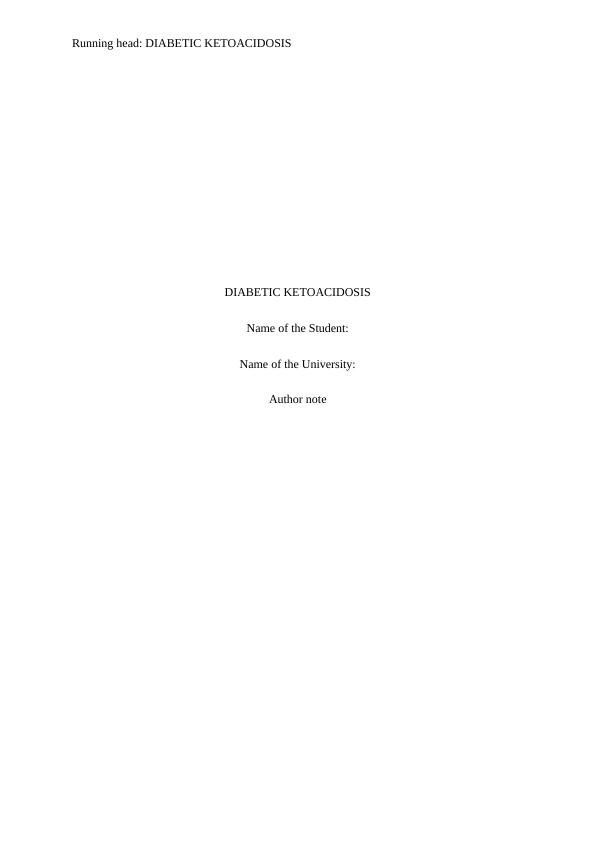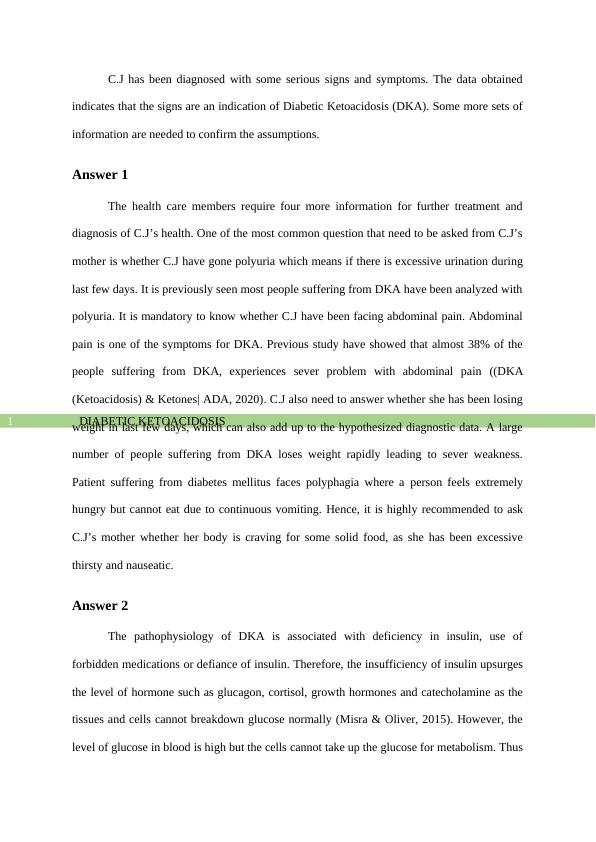Health Care - Diabetic Ketoacidosis
Added on 2022-08-25
7 Pages1587 Words21 Views
Running head: DIABETIC KETOACIDOSIS
DIABETIC KETOACIDOSIS
Name of the Student:
Name of the University:
Author note
DIABETIC KETOACIDOSIS
Name of the Student:
Name of the University:
Author note

DIABETIC KETOACIDOSIS1
C.J has been diagnosed with some serious signs and symptoms. The data obtained
indicates that the signs are an indication of Diabetic Ketoacidosis (DKA). Some more sets of
information are needed to confirm the assumptions.
Answer 1
The health care members require four more information for further treatment and
diagnosis of C.J’s health. One of the most common question that need to be asked from C.J’s
mother is whether C.J have gone polyuria which means if there is excessive urination during
last few days. It is previously seen most people suffering from DKA have been analyzed with
polyuria. It is mandatory to know whether C.J have been facing abdominal pain. Abdominal
pain is one of the symptoms for DKA. Previous study have showed that almost 38% of the
people suffering from DKA, experiences sever problem with abdominal pain ((DKA
(Ketoacidosis) & Ketones| ADA, 2020). C.J also need to answer whether she has been losing
weight in last few days, which can also add up to the hypothesized diagnostic data. A large
number of people suffering from DKA loses weight rapidly leading to sever weakness.
Patient suffering from diabetes mellitus faces polyphagia where a person feels extremely
hungry but cannot eat due to continuous vomiting. Hence, it is highly recommended to ask
C.J’s mother whether her body is craving for some solid food, as she has been excessive
thirsty and nauseatic.
Answer 2
The pathophysiology of DKA is associated with deficiency in insulin, use of
forbidden medications or defiance of insulin. Therefore, the insufficiency of insulin upsurges
the level of hormone such as glucagon, cortisol, growth hormones and catecholamine as the
tissues and cells cannot breakdown glucose normally (Misra & Oliver, 2015). However, the
level of glucose in blood is high but the cells cannot take up the glucose for metabolism. Thus
C.J has been diagnosed with some serious signs and symptoms. The data obtained
indicates that the signs are an indication of Diabetic Ketoacidosis (DKA). Some more sets of
information are needed to confirm the assumptions.
Answer 1
The health care members require four more information for further treatment and
diagnosis of C.J’s health. One of the most common question that need to be asked from C.J’s
mother is whether C.J have gone polyuria which means if there is excessive urination during
last few days. It is previously seen most people suffering from DKA have been analyzed with
polyuria. It is mandatory to know whether C.J have been facing abdominal pain. Abdominal
pain is one of the symptoms for DKA. Previous study have showed that almost 38% of the
people suffering from DKA, experiences sever problem with abdominal pain ((DKA
(Ketoacidosis) & Ketones| ADA, 2020). C.J also need to answer whether she has been losing
weight in last few days, which can also add up to the hypothesized diagnostic data. A large
number of people suffering from DKA loses weight rapidly leading to sever weakness.
Patient suffering from diabetes mellitus faces polyphagia where a person feels extremely
hungry but cannot eat due to continuous vomiting. Hence, it is highly recommended to ask
C.J’s mother whether her body is craving for some solid food, as she has been excessive
thirsty and nauseatic.
Answer 2
The pathophysiology of DKA is associated with deficiency in insulin, use of
forbidden medications or defiance of insulin. Therefore, the insufficiency of insulin upsurges
the level of hormone such as glucagon, cortisol, growth hormones and catecholamine as the
tissues and cells cannot breakdown glucose normally (Misra & Oliver, 2015). However, the
level of glucose in blood is high but the cells cannot take up the glucose for metabolism. Thus

DIABETIC KETOACIDOSIS2
increasing the blood glucose level more than 300mg/dL. Therefore, in order to maintain a
balance, there is an increase in lipase activity leading to the breakdown of adipose tissue. The
adipose tissue have a role in yielding fatty acids. These materials are then transformed to
acetyle coenzyme A, few of them enters Krebs cycle in order to generate energy and the
remnants are then broken down to ketones (Nyenwe & Kitabchi, 2016). These ketones adds
up to the smelling breath. Ketones usually accumulates faster and therefore can be used in
energy generation. Due to starvation, the body cannot use ketones. It leads to enhancement in
ketone production and reduction in the use of ketones for peripheral cells causes ketoacidosis.
Therefore, reduction in pH is observed far below 7.40 pH (Nyenwe & Kitabchi, 2016).
Consequently, a huge amount of ketones is lost during urination. Sodium also has an
important role in maintaining an electrolyte balance. Hence, sodium needed to buffer ketones
pulls large amount of water in renal tubules. Hence, producing large amount of urine and
imbalance in electrolytes. Due to huge amount of urination, the patient undergoes exhaustion
and dehydration in the patient’s body.
Answer 3
C.J has a blood pressure level of 90/50 mmHg. Normal systolic and diastolic blood
pressure recorded is 120.80 mmHg, nevertheless for a diabetic patient it ranges from 130-139
mmHg for systolic and 80-89 mmHg for diastolic (Maahs et al., 2015). C.J.’s blood pressure
noted to be 90/50 mmHg, which is low. It might be due to lack of food and dehydration. The
previous description showed that C.J. was unable to take any food as she had been
continuously vomiting and she had been feeling too much thirsty that means her body is
dehydrating. Therefore, these factors supports the analysis for C.J. suffering from low blood
pressure. C.J. has a very high heart rate of about 124 beats/min. Generally, female of 20 years
of age have a heart beat rate ranging from 60 to 100 beats/ min (Umpierrez & Korytkowski,
2016). This proves that might be increase in sugar level in C.J.’s blood. She had already been
increasing the blood glucose level more than 300mg/dL. Therefore, in order to maintain a
balance, there is an increase in lipase activity leading to the breakdown of adipose tissue. The
adipose tissue have a role in yielding fatty acids. These materials are then transformed to
acetyle coenzyme A, few of them enters Krebs cycle in order to generate energy and the
remnants are then broken down to ketones (Nyenwe & Kitabchi, 2016). These ketones adds
up to the smelling breath. Ketones usually accumulates faster and therefore can be used in
energy generation. Due to starvation, the body cannot use ketones. It leads to enhancement in
ketone production and reduction in the use of ketones for peripheral cells causes ketoacidosis.
Therefore, reduction in pH is observed far below 7.40 pH (Nyenwe & Kitabchi, 2016).
Consequently, a huge amount of ketones is lost during urination. Sodium also has an
important role in maintaining an electrolyte balance. Hence, sodium needed to buffer ketones
pulls large amount of water in renal tubules. Hence, producing large amount of urine and
imbalance in electrolytes. Due to huge amount of urination, the patient undergoes exhaustion
and dehydration in the patient’s body.
Answer 3
C.J has a blood pressure level of 90/50 mmHg. Normal systolic and diastolic blood
pressure recorded is 120.80 mmHg, nevertheless for a diabetic patient it ranges from 130-139
mmHg for systolic and 80-89 mmHg for diastolic (Maahs et al., 2015). C.J.’s blood pressure
noted to be 90/50 mmHg, which is low. It might be due to lack of food and dehydration. The
previous description showed that C.J. was unable to take any food as she had been
continuously vomiting and she had been feeling too much thirsty that means her body is
dehydrating. Therefore, these factors supports the analysis for C.J. suffering from low blood
pressure. C.J. has a very high heart rate of about 124 beats/min. Generally, female of 20 years
of age have a heart beat rate ranging from 60 to 100 beats/ min (Umpierrez & Korytkowski,
2016). This proves that might be increase in sugar level in C.J.’s blood. She had already been

End of preview
Want to access all the pages? Upload your documents or become a member.
Related Documents
Pathophysiology of Diabetic Ketoacidosislg...
|16
|3646
|65
Applied Pathophysiology Assignment Reportlg...
|10
|2490
|13
Case Study Based Nursing Assignmentlg...
|11
|3185
|12
NURS90076 - Report on Applied Pathophysiologylg...
|11
|2709
|310
Question | Insulin is a kind of hormone which is produced from pancreas inside the human body.lg...
|7
|1495
|11
Nursing Intervention.lg...
|13
|2543
|2
